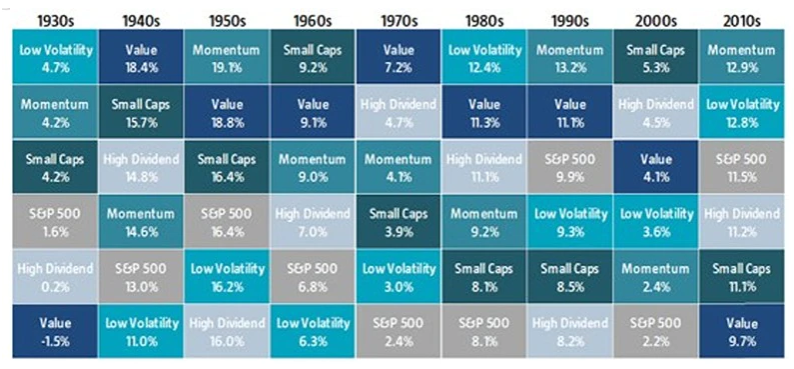As we mentioned in the first article of this series, factor premiums vary over time. Single-factor portfolios can experience periods of relative underperformance or outperformance lasting several years. For instance, small cap and value stocks performed dismally in the second half of the 1990s, while growth-like tech stocks reached stratospheric heights.
These large swings create the temptation to indulge in factor timing. Yet, success in this field of active management is far from easy. For one, the exact causes of these fluctuations remain a moot point. While factor performance seems to depend on macroeconomic conditions, the relationships between factor premiums and many key economic indicators have proven to be unstable over longer periods of time.1
Moreover, other elements may also have an influence. For instance, supply and demand considerations could play a role, as some single-factor strategies may be very popular at one in point in time, while others fall out of favor. Many empirical studies have documented widespread herding behavior, both into popular factor strategies and away from unloved ones.2
The academic literature reveals both a positive autocorrelation in the time series of factor premiums – in other words, factor momentum – and large fluctuations in the valuation of single-factor strategies over time.3 These two well-documented phenomena could, in theory, be used to tactically time factor exposures.
Arguably, however, one of the most popular timing approaches is to look at the relative valuation of different single-factor portfolios, usually using classic measures of valuation such as price-to-book or price-earnings ratios. The idea is to increase exposure to factors that trade at a discount compared to their historical norms and to reduce exposure to those exhibiting historically high valuations.4
Critics of this approach have argued that the simulated investment results obtained through this kind of strategy are not particularly strong and too highly correlated with conventional value factor strategies.5 Moreover, different measures of valuation often lead to conflicting conclusions. As a result, investors should generally refrain from timing factors, except on very rare occasions.
Heated arguments between Rob Arnott from Research Affiliates and Cliff Asness from AQR are the most obvious case in point.6 While Arnott has long been advocating for factor timing based on relative valuations of different factors, Asness has been consistently warning about the dangers and uncertain benefits of such tactical endeavors.
Timing factors based solely on their own past returns also appears to be challenging.7 However, recent studies take a fresh perspective and do report strong results for factor momentum. The key new insight is to consider a very short look-back period of just one month, and to apply it to many dozens of factors.8
Robeco research confirms these results but finds that the successful exploitation of this kind of factor momentum requires full integration into the bottom-up stock selection process of the factor strategies themselves.9 A naive approach to factor momentum – using momentum signals to rotate across a handful of single-factor portfolios – is too crude and costly to be worthwhile.
Of course, things are never completely black or white and, after months of intense public debate, leading voices from both camps – for and against factor-timing – have shown signs of appeasement. While some acknowledge that timing only works part of the time, others concede that timing could make sense in some rare cases.10
Discover the value of quant
Subscribe for cutting-edge quant strategies and insights.
Implementation costs shouldn’t be forgotten
Amidst the opposing views of supporters and adversaries of tactical factor timing, other academics and practitioners have advocated a halfway house: timing factors, but only to a limited extent – and with fair dose of caution.11 The idea is to use variables such as factor valuations, short-term factor momentum and macroeconomic indicators to predict short-term factor returns.
Based on these predictions, investors can tilt their portfolios towards the factors with the best prospects and away from the less promising ones. Some refer to this as factor rotation; others call it factor tilting. But while this may sound tempting, it requires two preconditions: sufficient prediction accuracy to deliver significant returns and relatively low costs of implementation to justify the effort.
Unfortunately, the academic literature on this topic leads to the conclusion that, for most investors, timing factor premiums is even more challenging than traditional market timing – which is already a notoriously difficult exercise.12 For sure, many empirical studies on general market timing contradict most of those experts who claim they can achieve it.13
In the case of factor premiums, the fact that factor strategies are dynamic and that portfolios need to be regularly rebalanced adds an additional layer of complexity to the problem. One way to overcome this would be to use low-fee generic smart beta products. But as we have seen in previous articles in this series, such products tend to be far from ideal and subject to numerous pitfalls.
Simulations by Robeco researchers also show that, on top of the technical challenges implied by factor timing, investors need quite accurate predictions of which factor will outperform in the short term – say, on a monthly or a quarterly basis – in order to beat a naive equal-weight allocation to various time-tested factors.
Investors would need to select the correct factor more than 50 to 60% of the time to outperform an equal-weight allocation to various factors. But our analysis ignored the fees investors would have to pay to their asset manager to deliver such timing accuracy. Once these fees are taken into account, the added value of factor timing becomes really dubious for the end investor.14
“
While factor timing may sound tempting, it requires two preconditions: sufficient prediction accuracy to deliver significant returns and relatively low costs of implementation
What investors should do about it? (The Robeco view)
Systematic tactical factor timing must therefore be taken with a dose of caution. A better option is often to opt for broad diversification across different factors, or for one particular factor of strategic interest, bearing in mind one or several factors could experience short-term underperformance, as illustrated by Figure 1. The graph shows the performance of generic factors across decades.
Figure 1: Factor performance across decades

Source: Robeco, based on Kenneth French Database and Paradoxinvesting.com
Ultimately, it is our view that patient investors who trade little and stick to their factor exposures are more likely to outperform the market in the long run. Sustainable investing is one way to ensure this, as investors often tend to be more committed to strategies that reflect their values, even when these temporarily underperform. That said, combining factor and sustainable investing is easier said than done. The debate on the role that sustainability should play in securities selection will be addressed in the following article in this series.
Factor investing debates: More stories
Footnotes
1This is one of the major pitfalls of factor timing raised in: Bender, J., Sun, X., Thomas, R. and Zdorovtsov, V., 2018, “The Promises and Pitfalls of Factor Timing”, The Journal of Portfolio Management.
2See: Gelderen, E., Huij, J. and Kyosev, G., 2019, “Factor Investing from Concept to Implementation”, The Journal of Portfolio Management. See also: Hsu, J. C., Myers, B. W. and Whitby, R. J., 2016, “Timing Poorly: A Guide to Generating Poor Returns While Investing in Successful Strategies”, The Journal of Portfolio Management. See also: Arnott, R. D., Beck, N., Kalesnik, V. and West, J., 2016, “How Can ‘Smart Beta’ Go Horribly Wrong?”, working paper. See also: Barberis, N., and Shleifer, A., 2003, “Style investing”, Journal of Financial Economics.
3See: Ilmanen, A., Israel, R., Moskovitz, T. J., Thapar, A. and Wang, F., 2019, “How Do Factor Premia Vary Over Time? A Century of Evidence”, working paper. [1]Asness, C., 2016, “The Siren Song of Factor timing”, Journal of Portfolio Management.
4Arnott, R. D., Beck, N. and Kalesnik, V., 2016, “Timing ‘Smart Beta’ Strategies? Of Course! Buy Low, Sell High!”, working paper.
5Asness, C., 2016, “The Siren Song of Factor timing”, Journal of Portfolio Management.
6See for example: Asness, C., 2016, “My Factor Philippic”, working paper.
7See for example: Arnott, R. D., Beck, N. and Kalesnik, V., 2017, “Forecasting Factor and Smart Beta Returns (Hint: History Is Worse than Useless)”, working paper.
8See, for example: Ehsani, S., and Linnainmaa, J., 2019, “Factor momentum and the momentum factor”, working paper. See also: Gupta, T., and Kelly, B., 2019, “Factor momentum everywhere”, Journal of Portfolio Management., See also: Arnott, R. D., Clemens, M., Kalesnik, V., and Linnainmaa, J., 2019, “Factor momentum”, working paper.
9Hanauer, M., Honarvar, I., Swinkels, L. and Zhou, W., 2020, “Exploiting short-term factor momentum”, Robeco client note.
10Asness, C., November 2019, “It’s Time for a Venial Value-Timing Sin”, article.
11See: Hodges, P., Hogan, K., Peterson, J. R. and Ang, A., 2017, “Factor Timing with Cross-Sectional and Time-Series Predictors”, The Journal of Portfolio Management.
12Asness, C., Ilmanen, A. and Maloney, T., 2017, “Market Timing: Sin a Little”, Journal of Investment Management.
13For a seminal paper on the subject, see for example: Sharpe, F. W., 1975, “Likely Gains from Market Timing”, Financial Analysts Journal.
14Blitz, D. C., Lansdorp. S., Roscovan, V. and Vidojevic, M., 2018, “The promises and challenges of factor timing”, Robeco client note.
Important information
This information is for informational purposes only and should not be construed as an offer to sell or an invitation to buy any securities or products, nor as investment advice or recommendation. The contents of this document have not been reviewed by the Monetary Authority of Singapore (“MAS”). Robeco Singapore Private Limited holds a capital markets services license for fund management issued by the MAS and is subject to certain clientele restrictions under such license. An investment will involve a high degree of risk, and you should consider carefully whether an investment is suitable for you.

















